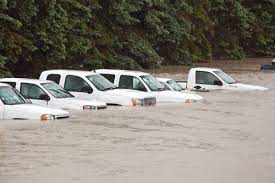When looking for a used car, buyers must be aware of the potential hazards accompanying pre-owned vehicles. One of the most significant risks is inadvertently purchasing a car that has suffered flood damage. Riverside Toyota understands the importance of informed decision-making, and this article aims to help potential buyers by outlining the key steps to spotting flood-damaged used cars. Following the expert advice provided here, one can feel more confident in their choice and ultimately invest in a reliable and safe used vehicle.
Table of Contents
Check for Telltale Signs of Water Damage
When examining a used car, pay close attention to any signs of water damage. Some common indicators include:
- Rust in unexpected places, like under the seats or on the screws and bolts
- Waterlines or mud residue in the trunk, engine compartment, or other nooks and crannies
- A musty or moldy smell in the interior, particularly in the upholstery and carpeting
- Discoloration, warping, or staining of the interior materials
If you notice these signs, digging deeper and investigating further is a good idea.
Inspect the Electrical System
Floodwater can wreak havoc on a car’s electrical system, leading to short circuits, corrosion, and other issues. When evaluating a used car, take the time to inspect its electrical components thoroughly. Check for:
- Flickering or dimming dashboard lights
- Malfunctioning power windows or door locks
- Faulty or non-working radio, GPS, or other electronic features
- Unusual electrical issues, such as blown fuses or warning lights on the dashboard
If you encounter any of these problems, it could indicate that the car has sustained flood damage.
Examine the Engine and Transmission
Floodwater can cause significant damage to a vehicle’s engine and transmission, leading to costly repairs down the road. To avoid these headaches, be sure to:
- Check the oil for signs of water contamination, such as a milky or frothy appearance
- Inspect the air filter for water stains or dirt residue, which could indicate water intrusion
- Look for rust or corrosion on the engine components and under the hood
- Test drive the car and listen for any unusual sounds or performance issues
If you have any concerns about the engine or transmission, it’s best to consult a professional mechanic for a thorough inspection.
Obtain a Vehicle History Report
One of the best ways to determine if a used car has a flood damage history is by obtaining a vehicle history report. Services like CARFAX and AutoCheck can provide valuable information about a car’s past, including:
- Accident history and previous repairs
- Title history, including any salvage or flood titles
- Odometer readings and potential discrepancies
- Ownership history and previous locations
Reviewing this information gives you a clearer picture of a car’s history and any potential red flags.
Consult with a Trusted Mechanic
Finally, one of the best ways to ensure you’re purchasing a reliable used car is to inspect it with a trusted mechanic. A professional can thoroughly evaluate the vehicle, identify any hidden issues, and provide an unbiased assessment of its condition.
By following these tips and working with a reputable dealership, you can feel confident in your purchase and enjoy peace of mind for years.
Spotting a flood-damaged used car can be a challenging task. Still, following the tips outlined in this guide can significantly reduce the risk of purchasing a problematic vehicle. Remember to inspect for signs of water damage, check the electrical system, examine the engine and transmission, obtain a vehicle history report, and consult a trusted mechanic. By taking these precautions and working with a reputable dealership like Riverside Toyota, you can make an informed decision and drive away with confidence in your next used car purchase. Stay vigilant and happy car hunting!

